Flexible Continuous-Time Modeling for Multi-Objective Day-Ahead Scheduling of CHP Units
Abstract
1. Introduction
2. Problem Modeling
2.1. Discrete-Time Multi-Objective CHP Scheduling
2.1.1. Multi-Objective Programming Based on ε-Constraint Method
2.1.2. Objective Functions
2.2. Continuous-Time Multi-Objective CHP Scheduling Model
3. Cubic Spline Model for Multi-Objective Scheduling of CHPs
3.1. Modeling the Generation/Demand Trajectories and Operating Constraints
3.1.1. Continuous-Time Modeling of the Generation/Demand Trajectories
3.1.2. Continuous-Time Modeling of the Power Balance Equations
3.1.3. Continuous-Time Modeling of the Box Constraints
3.1.4. Continuous-Time Modeling of the CHP Characteristic Points
3.1.5. Modeling Ramping Constraints
3.2. Modeling the Objective Functions
3.2.1. Continuous-time modeling of the cost function as the main objective
3.2.2. Continuous-Time Modeling of the Emission Function Based on ε-Constraint
3.2.3. Enforcing the Continuity Constraints
4. Numerical Results and Discussion
- Keep the solution points, the decision space, and the non-dominated solutions in the objective space;
- Preserve the algorithmic progress toward the Pareto front;
- Keep the diversity of Pareto front solutions;
- Provide a large enough but limited number of solutions for the Pareto front;
- Search the best compromise solutions (BCSs) among the solution points of the Pareto front.
- (a)
- Even though the solution points in both Pareto curves in Figure 6 are well distributed, it is clear that the solutions of the continuous-one outperform the non-dominated solutions of the hourly model. However, according to the results of Table 1, the BCS of continuous-time modeling is obtained with a trade-off between 3269 (USD) increase in total day-ahead cost and 434 (kg) increase in total emission with regards to the hourly scheduling. Meanwhile, the real-time operation cost and emission are 113,180 (USD) and 10,655 (kg) for Case I as well as 40,227 (USD) and 4443 (kg) for Case II, respectively. This result highlights cost-saving of 69,684 (USD) (1.67%) and emission saving of 57,778 (kg) (1.46%) in day-ahead scheduling, which is substantial.
- (b)
- Ramping scarcities can increase overall system costs because of the penalty prices due to the ramping capability shortage. Prevention of more ramp scarcities is another fundamental characteristic of the Bernstein expansion, which delivers accuracy and tighter function. For evaluating this attribute, the ramping values of the thermal units are determined by scaling down the maximum value of the units by a ratio of fifteen. In this case, the results represent 6 ramping scarcity events for the hourly based model in comparison with no scarcity events for the proposed model.
- (c)
- The last row in Table 1 shows the computing time of the case studies in a minute, while the upper bound on the duality gap is set to zero. The execution time of the hourly day-ahead operation is 0.3648 min, which is lower than that of the proposed function space-based model, 1.9433 min. It is clear that the proposed method is approximately slower by 5 due to having more variables and constraints in the Bernstein polynomial-based modeling. This shows the main drawback of this expansion, especially when the accuracy of polynomials is increased. However, reducing the accuracy of the polynomials can bring about a significant reduction in the computational burden. Hence, relying on the problem, a tradeoff between accuracy and time should be determined.
5. Conclusions
Author Contributions
Funding
Institutional Review Board Statement
Informed Consent Statement
Data Availability Statement
Acknowledgments
Conflicts of Interest
Nomenclature
| |
| Total generation cost of units (USD) | |
| Total emission of units (kg) | |
| , and | Generation cost of thermal, CHP and heat-only units |
| , and | CO2 emission of thermal, CHP and heat-only units |
| |
| Power vector including power generation of units (MW) | |
| Vector of electric load demand (MW) | |
| Vector of thermal units’ power (MW) | |
| Vector of CHP units’ power (MW) | |
| Heat vector including heat generation of units (MW) | |
| Vector of heat demand (MW) | |
| Vector of CHP units’ heat (MW) | |
| Vector of heat-only units’ heat (MW) | |
| Time derivatives of the thermal and CHP units’ power generation | |
| Vector of thermal units’ ramp up and ramp down, respectively (MW/h) | |
| Vector of CHP units’ ramp up and ramp down, respectively (MW/h) | |
| Cost, power, heat, and coefficient matrices (-by-) of characteristic points for CHP units, respectively | |
| R-dimensional vector of ones | |
| Identity matrix of order R | |
| Standard vector (with a 1 in the Rth coordinate and zeros elsewhere) | |
| |
| The number of thermal units | |
| The number of CHP units | |
| The number of heat-only units | |
| The number of piecewise segments | |
| The number of characteristic points | |
| Degree of Bernstein polynomials | |
| Bernstein-basis functions of degree Q | |
| |
| Power generation output of thermal unit i | |
| Power generation output of CHP unit j | |
| Heat production of CHP unit j | |
| Heat production of heat-only unit k | |
| CHP units’ ramp up and ramp down, respectively (MW/h) | |
| Decision variable encoding the convex combination of the operating region of CHP unit j | |
| Characteristic points of CHP unit j | |
| , | Auxiliary power and heat generation variables of thermal and heat-only units, respectively |
| |
| Index of thermal units | |
| Index of CHP units | |
| Index of characteristic points of CHP units | |
| Index of heat-only units | |
| Index of linearization segments | |
| Index of the hourly time interval | |
| Index set of thermal units | |
| Index set of CHP units | |
| Index set of characteristic points of CHP units | |
| Index set of heat-only units | |
| Index set of linearization segments | |
| Index set of hourly time interval | |
| Day-ahead scheduling horizon | |
| |
| or | Thermal |
| or | Combined heat and power |
| or | Heat-only |
| / | Minimum/maximum magnitude operator |
| |
| , and | Cost coefficients of thermal units i |
| , and | Cost coefficients of heat-only units k |
| , and | Emission coefficients of thermal units i |
| and | Emission coefficients of heat-only units k |
| and | Emission coefficients of CHP units j |
| |
| Transpose operator | |
| diag’s operator, which returns a column vector of the main diagonal elements of | |
| Element-wise multiplication operator which multiplies arrays and , element by element | |
Appendix A
| Thermal Unit | ||||||||
|---|---|---|---|---|---|---|---|---|
| TH 1 | 0.02069 | 14.83 | 57.11 | 0.00683 | −0.54551 | 40.2669 | 800 | 0 |
| TH 2 | 0.03232 | 18.54 | 57.11 | 0.00683 | −0.54551 | 40.2669 | 500 | 0 |
| TH 3 | 0.01065 | 60.26 | 126.8 | 0.00461 | −0.51116 | 42.8955 | 500 | 0 |
| TH 4 | 0.04222 | 21.19 | 57.11 | 0.00461 | −0.51116 | 42.8955 | 450 | 0 |
| Heat-Only Unit | |||||||
|---|---|---|---|---|---|---|---|
| H 1 | 0.0105 | 10.55 | 23.426 | 0.32767 | 13.85932 | 300 | 0 |
| H 2 | 0.0299 | 9.21 | 10.721 | 0.32767 | 13.85932 | 270 | 0 |
| CHP Unit | |||||
|---|---|---|---|---|---|
| CHP 1 | 247, 215, 118, 89 | 0, 240, 104.8, 0 | 1306.85, 1954.2646, 705.6, 982 | −0.5734 | 311.57 |
| CHP 2 | 125, 110, 114, 75 | 0, 235, 35, 0 | 1030, 2123, 1120, 1419 | −1.7669 | 821.65 |
References
- Zappa, W.; Junginger, M.; van den Broek, M. Is a 100% renewable European power system feasible by 2050? Appl. Energy 2019, 233, 1027–1050. [Google Scholar] [CrossRef]
- Renau, J.; García, V.; Domenech, L.; Verdejo, P.; Real, A.; Giménez, A.; Sánchez, F.; Lozano, A.; Barreras, F. Novel Use of Green Hydrogen Fuel Cell-Based Combined Heat and Power Systems to Reduce Primary Energy Intake and Greenhouse Emissions in the Building Sector. Sustainability 2021, 13, 1776. [Google Scholar] [CrossRef]
- Kim, D.; Kim, K.-T.; Park, Y.-K. A Comparative Study on the Reduction Effect in Greenhouse Gas Emissions between the Combined Heat and Power Plant and Boiler. Sustainability 2020, 12, 5144. [Google Scholar] [CrossRef]
- Mohammadi, A.; Venkatesh, G.; Sandberg, M.; Eskandari, S.; Joseph, S.; Granström, K. A Comprehensive Environmental Life Cycle Assessment of the Use of Hydrochar Pellets in Combined Heat and Power Plants. Sustainability 2020, 12, 9026. [Google Scholar] [CrossRef]
- Pourghasem, P.; Sohrabi, F.; Abapour, M.; Mohammadi-Ivatloo, B. Stochastic multi-objective dynamic dispatch of renewable and CHP-based islanded microgrids. Electr. Power Syst. Res. 2019, 173, 193–201. [Google Scholar] [CrossRef]
- Gbadamosi, S.L.; Nwulu, N.I. Optimal power dispatch and reliability analysis of hybrid CHP-PV-wind systems in farming applications. Sustainability 2020, 12, 8199. [Google Scholar] [CrossRef]
- Mohammadi-Ivatloo, B.; Moradi-Dalvand, M.; Rabiee, A. Combined heat and power economic dispatch problem solution using particle swarm optimization with time varying acceleration coefficients. Electr. Power Syst. Res. 2013, 95, 9–18. [Google Scholar] [CrossRef]
- Lund, R.; Mathiesen, B.V. Large combined heat and power plants in sustainable energy systems. Appl. Energy 2015, 142, 389–395. [Google Scholar] [CrossRef]
- Ahmadi, A.; Moghimi, H.; Nezhad, A.E.; Agelidis, V.G.; Sharaf, A.M. Multi-objective economic emission dispatch considering combined heat and power by normal boundary intersection method. Electr. Power Systems Res. 2015, 129, 32–43. [Google Scholar] [CrossRef]
- Aghaei, J.; Alizadeh, M.-I. Multi-objective self-scheduling of CHP (combined heat and power)-based microgrids considering demand response programs and ESSs (energy storage systems). Energy 2013, 55, 1044–1054. [Google Scholar] [CrossRef]
- Soroudi, A.; Mohammadi-Ivatloo, B.; Rabiee, A. Energy hub management with intermittent wind power. In Large Scale Renewable Power Generation; Springer: Berlin/Heidelberg, Germany, 2014; Chapter 16; pp. 413–438. [Google Scholar]
- Mavrotas, G. Effective implementation of the ε-constraint method in multi-objective mathematical programming problems. Appl. Math. Comput. 2009, 213, 455–465. [Google Scholar] [CrossRef]
- Javadi, M.; Lotfi, M.; Osório, G.J.; Ashraf, A.; Nezhad, A.E.; Gough, M.; Catalão, J.P. A multi-objective model for home energy management system self-scheduling using the epsilon-constraint method. In Proceedings of the 2020 IEEE 14th International Conference on Compatibility, Power Electronics and Power Engineering (CPE-POWERENG), Setubal, Portugal, 8–10 July 2020; pp. 175–180. [Google Scholar]
- Kia, M.; Nazar, M.S.; Sepasian, M.S.; Heidari, A.; Siano, P. Optimal day ahead scheduling of combined heat and power units with electrical and thermal storage considering security constraint of power system. Energy 2017, 120, 241–252. [Google Scholar] [CrossRef]
- Nazari-Heris, M.; Mehdinejad, M.; Mohammadi-Ivatloo, B.; Babamalek-Gharehpetian, G. Combined heat and power economic dispatch problem solution by implementation of whale optimization method. Neural Comput. Appl. 2019, 31, 421–436. [Google Scholar] [CrossRef]
- Nazari-Heris, F.; Mohammadi-ivatloo, B.; Nazarpour, D. Network constrained economic dispatch of renewable energy and CHP based microgrids. Int. J. Electr. Power Energy Syst. 2019, 110, 144–160. [Google Scholar] [CrossRef]
- Kopanos, G.M.; Georgiadis, M.C.; Pistikopoulos, E.N. Energy production planning of a network of micro combined heat and power generators. Appl. Energy 2013, 102, 1522–1534. [Google Scholar] [CrossRef]
- Alomoush, M.I. Optimal Combined Heat and Power Economic Dispatch Using Stochastic Fractal Search Algorithm. J. Mod. Power Syst. Clean Energy 2020, 8, 276–286. [Google Scholar] [CrossRef]
- Carrión, M.; Arroyo, J.M. A computationally efficient mixed-integer linear formulation for the thermal unit commitment problem. IEEE Trans. Power Syst. 2006, 21, 1371–1378. [Google Scholar] [CrossRef]
- Alipour, M.; Zare, K.; Seyedi, H. A multi-follower bilevel stochastic programming approach for energy management of combined heat and power micro-grids. Energy 2018, 149, 135–146. [Google Scholar] [CrossRef]
- Alipour, M.; Zare, K.; Zareipour, H.; Seyedi, H. Hedging strategies for heat and electricity consumers in the presence of real-time demand response programs. IEEE Trans. Sustain. Energy 2018, 10, 1262–1270. [Google Scholar] [CrossRef]
- Wang, J.; You, S.; Zong, Y.; Træholt, C.; Zhou, Y.; Mu, S. Optimal dispatch of combined heat and power plant in integrated energy system: A state of the art review and case study of Copenhagen. Energy Procedia 2019, 158, 2794–2799. [Google Scholar] [CrossRef]
- Wang, J.; You, S.; Zong, Y.; Træholt, C.; Dong, Z.Y.; Zhou, Y. Flexibility of combined heat and power plants: A review of technologies and operation strategies. Appl. Energy 2019, 252, 113445. [Google Scholar] [CrossRef]
- Bagherian, M.A.; Mehranzamir, K. A comprehensive review on renewable energy integration for combined heat and power production. Energy Convers. Manag. 2020, 224, 113454. [Google Scholar] [CrossRef]
- Parvania, M.; Scaglione, A. Unit commitment with continuous-time generation and ramping trajectory models. IEEE Trans. Power Syst. 2015, 31, 3169–3178. [Google Scholar] [CrossRef]
- Parvania, M.; Scaglione, A. Generation ramping valuation in day-ahead electricity markets. In Proceedings of the 2016 49th Hawaii International Conference on System Sciences (HICSS), Koloa, HI, USA, 5–8 January 2016; pp. 2335–2344. [Google Scholar]
- Li, B.; Bagherinezhad, A.; Khatami, R.; Parvania, M. Continuous-Time Look-Ahead Optimization of Energy Storage in Real-Time Balancing and Regulation Markets. IEEE Syst. J. 2020. [Google Scholar] [CrossRef]
- Khatami, R.; Parvania, M. Continuous-Time Locational Marginal Price of Electricity. IEEE Access 2019, 7, 129480–129493. [Google Scholar] [CrossRef]
- Bagherinezhad, A.; Khatami, R.; Parvania, M. Continuous-time look-ahead flexible ramp scheduling in real-time operation. Int. J. Electr. Power Energy Syst. 2020, 119, 105895. [Google Scholar] [CrossRef]
- Davoodi, E.; Babaei, E.; Mohammadi-Ivatloo, B.; Rasouli, M. A novel fast semidefinite programming-based approach for optimal reactive power dispatch. IEEE Trans. Ind. Inform. 2019, 16, 288–298. [Google Scholar] [CrossRef]
- Rong, A.; Hakonen, H.; Lahdelma, R. An efficient linear model and optimisation algorithm for multi-site combined heat and power production. Eur. J. Oper. Res. 2006, 168, 612–632. [Google Scholar] [CrossRef]
- Wang, H.; Yin, W.; Abdollahi, E.; Lahdelma, R.; Jiao, W. Modelling and optimization of CHP based district heating system with renewable energy production and energy storage. Appl. Energy 2015, 159, 401–421. [Google Scholar] [CrossRef]
- Davoodi, E.; Babaei, E.; Mohammadi-Ivatloo, B.; Shafie-Khah, M.; Catalão, J.P. Multiobjective Optimal Power Flow Using a Semidefinite Programming-Based Model. IEEE Syst. J. 2020, 15, 158–169. [Google Scholar] [CrossRef]
- Parvania, M.; Khatami, R. Continuous-time marginal pricing of electricity. IEEE Trans. Power Syst. 2016, 32, 1960–1969. [Google Scholar] [CrossRef]
- Dierckx, P. Curve and Surface Fitting with Splines; Oxford University Press: New York, NY, USA, 1995. [Google Scholar]
- Soroudi, A. Power System Optimization Modeling in GAMS; Springer: Berlin/Heidelberg, Germany, 2017; Volume 78. [Google Scholar]
- California ISO Open Access Same-Time Information System (OASIS). June 2018. Available online: http://oasis.caiso.com (accessed on 29 April 2021).
- Brook, A.; Kendrick, D.; Meeraus, A. GAMS, a user’s guide. ACM Signum Newsl. 1988, 23, 10–11. [Google Scholar] [CrossRef]
- Chiandussi, G.; Codegone, M.; Ferrero, S.; Varesio, F.E. Comparison of multi-objective optimization methodologies for engineering applications. Comput. Math. Appl. 2012, 63, 912–942. [Google Scholar] [CrossRef]
- Aghaei, J.; Amjady, N.; Shayanfar, H.A. Multi-objective electricity market clearing considering dynamic security by lexicographic optimization and augmented epsilon constraint method. Appl. Soft Comput. 2011, 11, 3846–3858. [Google Scholar] [CrossRef]
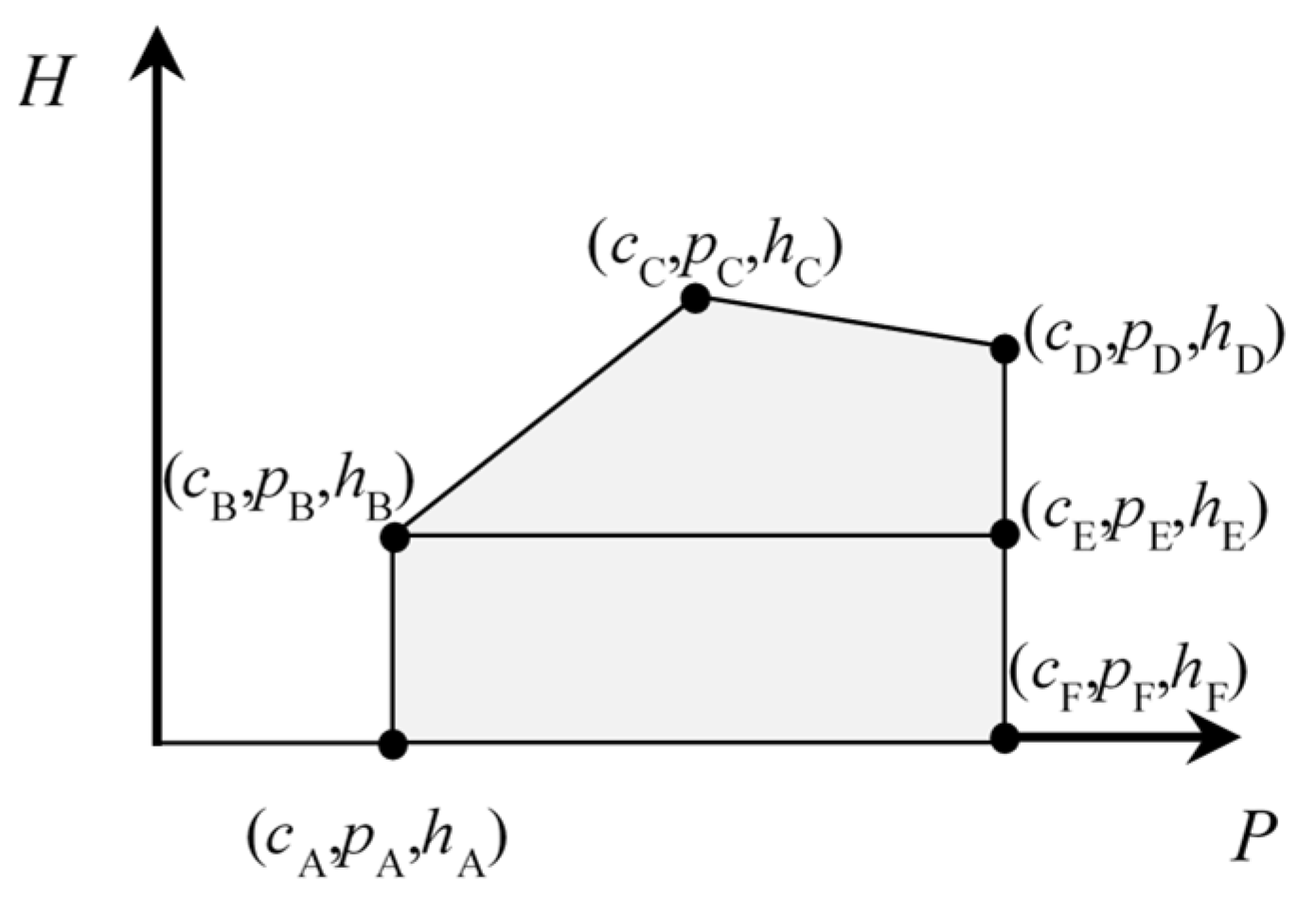
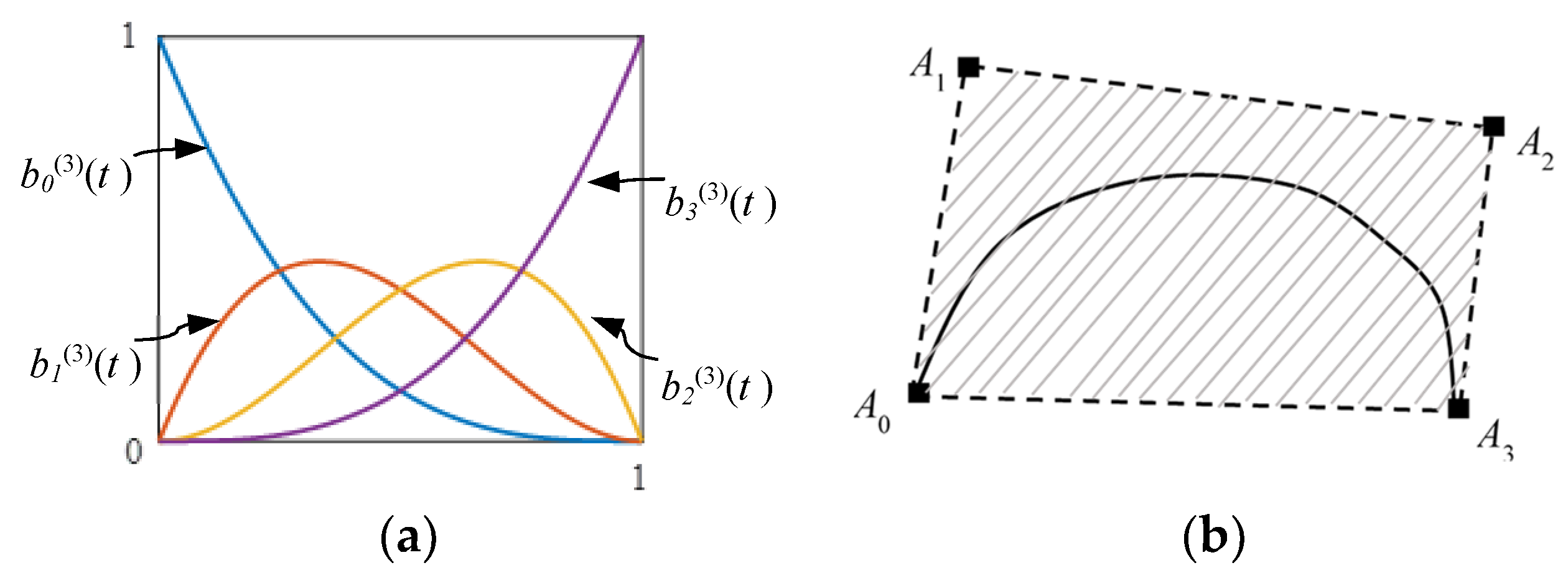
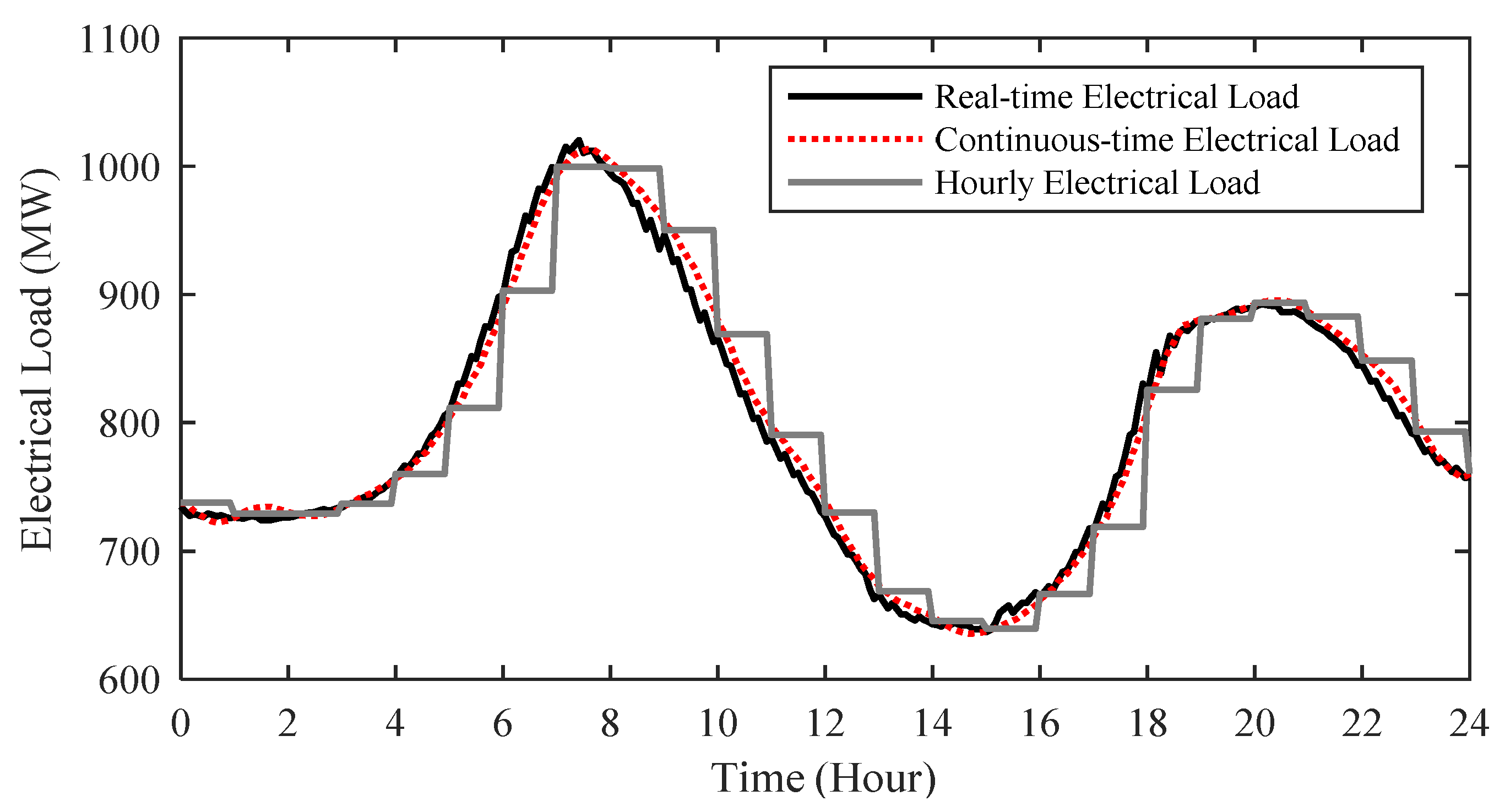
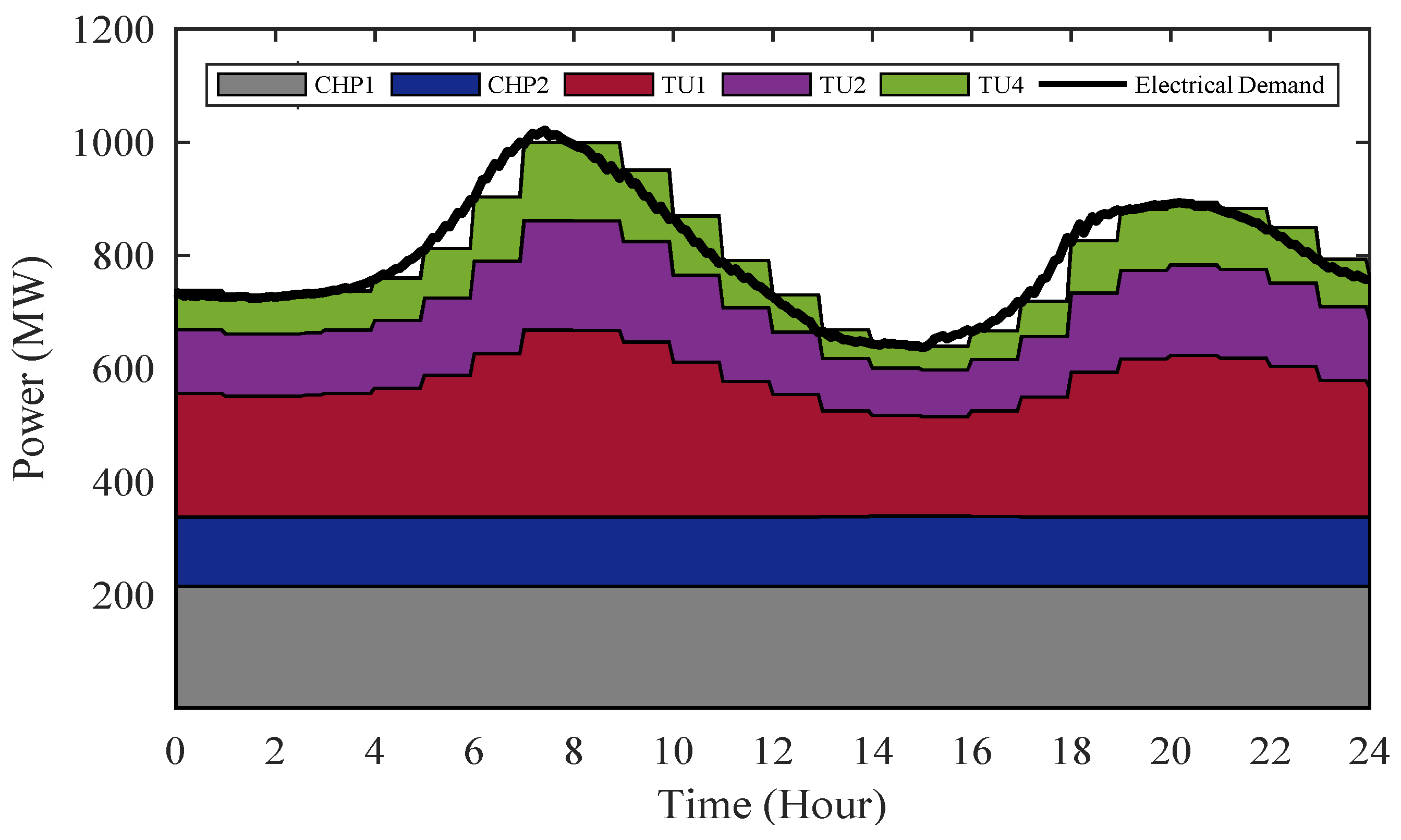
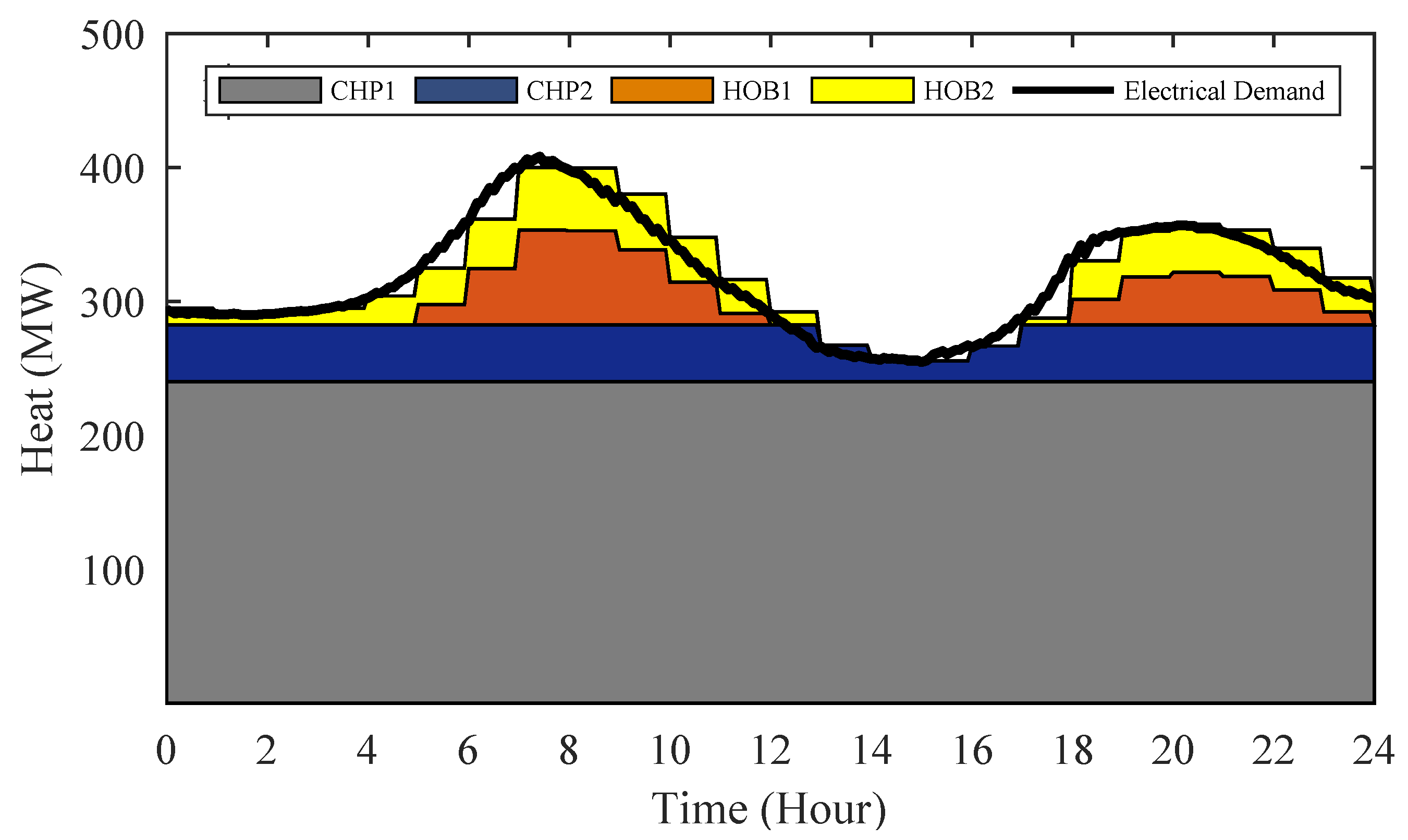
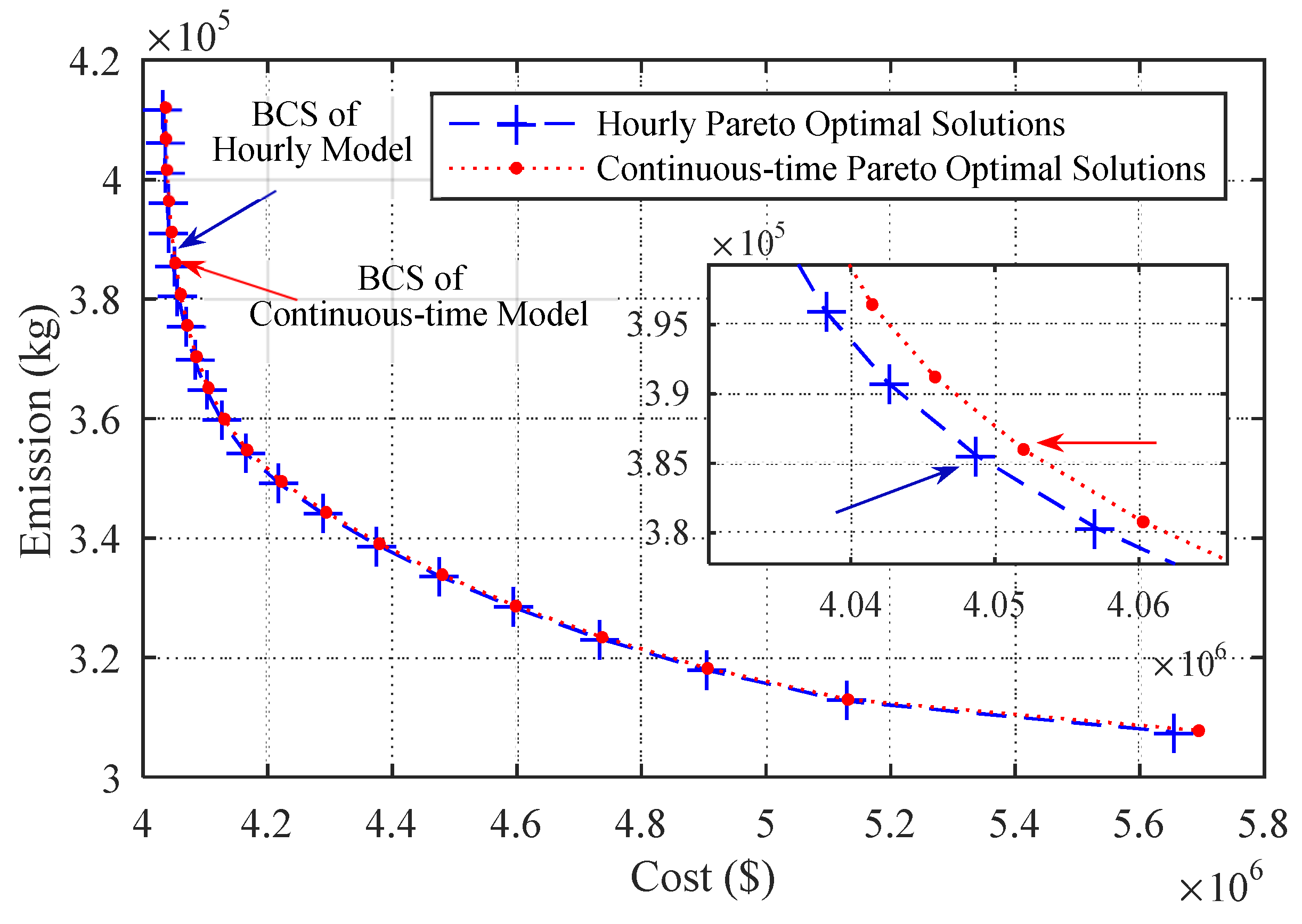

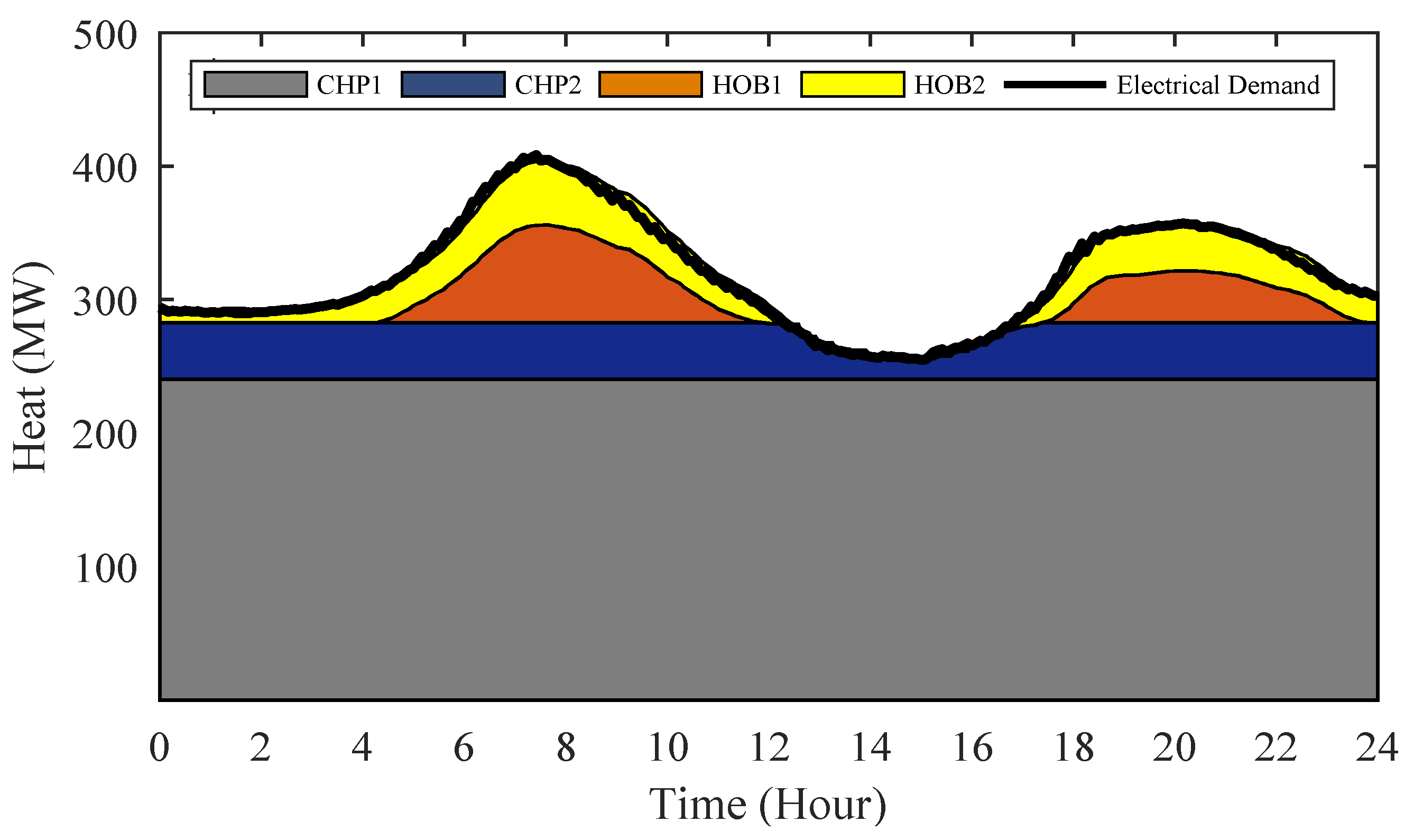
| Hourly Model (Study I) | Continuous-Time Model (Study II) | |
|---|---|---|
| Total Day-ahead Cost (USD) | 4,048,725 | 4,051,994 |
| Real-time Operation Cost (USD) | 113,180 | 40,227 |
| Total Operation Cost (USD) | 4,161,905 | 4,092,221 |
| Cost Saving (USD) | - | 69,684 (1.67%) |
| Total Day-ahead Emission (kg) | 385,565 | 385,999 |
| Real-time Emission (kg) | 10,655 | 4443 |
| Total Emission (kg) | 396,221 | 390,443 |
| Emission Reduction (kg) | - | 57,778 (1.46%) |
| Computed time (min) | 0.3648 | 1.9433 |
Publisher’s Note: MDPI stays neutral with regard to jurisdictional claims in published maps and institutional affiliations. |
© 2021 by the authors. Licensee MDPI, Basel, Switzerland. This article is an open access article distributed under the terms and conditions of the Creative Commons Attribution (CC BY) license (https://creativecommons.org/licenses/by/4.0/).
Share and Cite
Davoodi, E.; Balaei-Sani, S.; Mohammadi-Ivatloo, B.; Abapour, M. Flexible Continuous-Time Modeling for Multi-Objective Day-Ahead Scheduling of CHP Units. Sustainability 2021, 13, 5058. https://doi.org/10.3390/su13095058
Davoodi E, Balaei-Sani S, Mohammadi-Ivatloo B, Abapour M. Flexible Continuous-Time Modeling for Multi-Objective Day-Ahead Scheduling of CHP Units. Sustainability. 2021; 13(9):5058. https://doi.org/10.3390/su13095058
Chicago/Turabian StyleDavoodi, Elnaz, Salar Balaei-Sani, Behnam Mohammadi-Ivatloo, and Mehdi Abapour. 2021. "Flexible Continuous-Time Modeling for Multi-Objective Day-Ahead Scheduling of CHP Units" Sustainability 13, no. 9: 5058. https://doi.org/10.3390/su13095058
APA StyleDavoodi, E., Balaei-Sani, S., Mohammadi-Ivatloo, B., & Abapour, M. (2021). Flexible Continuous-Time Modeling for Multi-Objective Day-Ahead Scheduling of CHP Units. Sustainability, 13(9), 5058. https://doi.org/10.3390/su13095058







